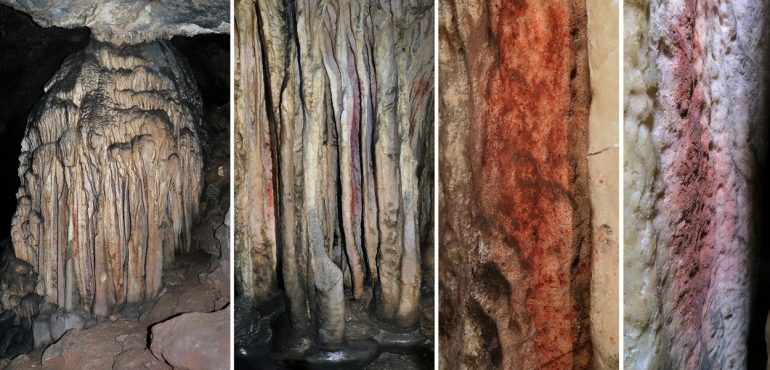At what point in human history did our ancestors first become artistic? A new analysis of red pigments in the Spanish cave Cueva de Ardales shows that these were apparently applied intentionally – some 65,000 years ago. These markings were made 20,000 years before the arrival of anatomically modern humans in Europe. Analysis suggests that Neanderthals used red to mark religiously significant sites.
Cueva de Ardales in the Spanish province of Málaga is home to many rock paintings from different millennia. The 1600-metre-long cave was discovered in 1821 after an earthquake exposed the entrance. The first rock paintings were identified in 1918. Many figurative images of animals and various symbols are known. A large stalagmite dome in the vicinity of the cave entrance also has reddish pigments on the rocks, for which it was previously disputed whether they were deposited through natural processes or whether they were also human.
Neanderthal painting
A team led by Afrika Pietarch Marti from the University of Barcelona in Spain has now analyzed the composition of these pigments using various microscopic and spectroscopic methods and compared it with other minerals in the cave. “Our results contradict the notion that colors may be the result of natural processes,” report the researchers. The arrangement and composition of the pigments make it clear that they cannot be caused by seepage water accumulation or by natural weathering of the walls. The researchers were also able to rule out microbial activities.
Some specimens date back to about 65,500 years. There were no physically modern people in Europe at that time. The colors on the rocks clearly come from Neanderthals who settled the area in the Paleolithic period. According to analyses, the main components of the red color are the iron-containing minerals hematite, aluminum silicate and calcite. They also found quartz and diamond-like carbon layers in some of the microscopic samples they took. Comparison with other cave specimens revealed: The color is very likely not from the cave itself. “Our results suggest that the Palaeolithic artists used iron-rich lumps that had been collected in geological formations from an as yet unknown source, which likely could have been found outside the cave,” the researchers said. .
no art in the strict sense
But were the pigments actually applied intentionally? In other cases, it has already been argued that the discoloration on rock walls may have arisen accidentally when early humans with dyed clothing or body paint grazed along narrow spaces. Marty and his colleagues can rule this out, however: “The structures depicted are in the middle of a very large chamber,” he explains. In addition, pigments are also found in deep crevices in the rock – one can reach deep even with a hand. According to the researchers, there was a possibility of blowing or spraying the paint. It also fits into the distribution pattern, with the color being strongest in the middle and decreasing towards the edges.
Still, researchers do not classify paint applications as art in the narrowest sense. This would require that the images themselves have a symbolic value. Marty and his colleagues wrote, “We believe that the cave itself is the symbol and the paintings are meant to identify them as such, and not the other way around.” “So they are more the result of a graphic behavior that aims to perpetuate the symbolic meaning of a room.”
symbolic place across generations
The dating of the pigments shows that they were applied at different times – initially around 65,500 years ago and later again between 48,700 and 45,300 years ago. The composition of pigments at different times also differs slightly. “Combining both lines of evidence, dating and composition, we can be sure that our samples represent at least two convicts, and we can also assume that their actual number is at least three or maybe even four.” Maybe,” say the researchers.
They conclude from this that several generations of Neanderthals visited the cave and marked it repeatedly over thousands of years. Apparently he had the motivation to return to the cave again and again and to symbolically mark the place. “Our results support the hypothesis that Neanderthals used these images and the large stalagmite dome that held them symbolically over a long period of time.”
Source: Africa Pietark Marti (University of Barcelona, Spain) et al., Proceedings of the National Academy of Sciences, doi:10.1073/pnas.2021495118

Web guru. Amateur thinker. Unapologetic problem solver. Zombie expert. Hipster-friendly travel geek. Social mediaholic.





